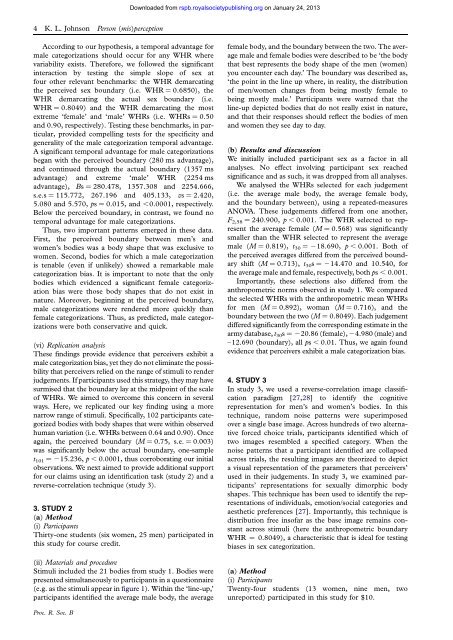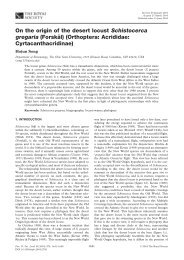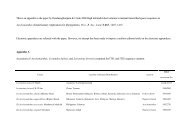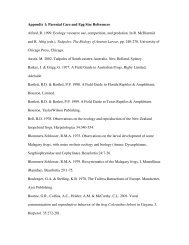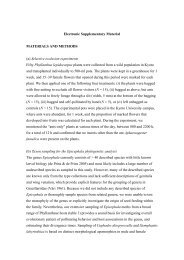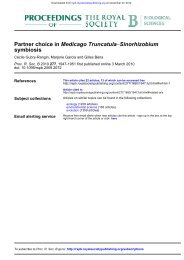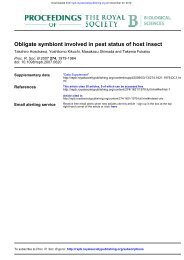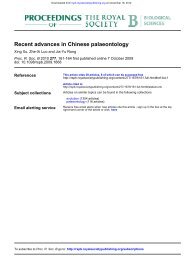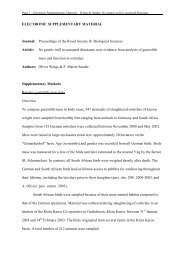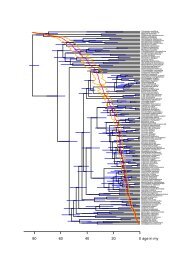Person (mis)perception: functionally biased sex categorization of ...
Person (mis)perception: functionally biased sex categorization of ...
Person (mis)perception: functionally biased sex categorization of ...
You also want an ePaper? Increase the reach of your titles
YUMPU automatically turns print PDFs into web optimized ePapers that Google loves.
4 K. L. Johnson <strong>Person</strong> (<strong>mis</strong>)<strong>perception</strong><br />
According to our hypothesis, a temporal advantage for<br />
male <strong>categorization</strong>s should occur for any WHR where<br />
variability exists. Therefore, we followed the significant<br />
interaction by testing the simple slope <strong>of</strong> <strong>sex</strong> at<br />
four other relevant benchmarks: the WHR demarcating<br />
the perceived <strong>sex</strong> boundary (i.e. WHR ¼ 0.6850), the<br />
WHR demarcating the actual <strong>sex</strong> boundary (i.e.<br />
WHR ¼ 0.8049) and the WHR demarcating the most<br />
extreme ‘female’ and ‘male’ WHRs (i.e. WHRs ¼ 0.50<br />
and 0.90, respectively). Testing these benchmarks, in particular,<br />
provided compelling tests for the specificity and<br />
generality <strong>of</strong> the male <strong>categorization</strong> temporal advantage.<br />
A significant temporal advantage for male <strong>categorization</strong>s<br />
began with the perceived boundary (280 ms advantage),<br />
and continued through the actual boundary (1357 ms<br />
advantage) and extreme ‘male’ WHR (2254 ms<br />
advantage), Bs ¼ 280.478, 1357.308 and 2254.666,<br />
s.e.s ¼ 115.772, 267.196 and 405.133, zs ¼ 2.420,<br />
5.080 and 5.570, ps ¼ 0.015, and ,0.0001, respectively.<br />
Below the perceived boundary, in contrast, we found no<br />
temporal advantage for male <strong>categorization</strong>s.<br />
Thus, two important patterns emerged in these data.<br />
First, the perceived boundary between men’s and<br />
women’s bodies was a body shape that was exclusive to<br />
women. Second, bodies for which a male <strong>categorization</strong><br />
is tenable (even if unlikely) showed a remarkable male<br />
<strong>categorization</strong> bias. It is important to note that the only<br />
bodies which evidenced a significant female <strong>categorization</strong><br />
bias were those body shapes that do not exist in<br />
nature. Moreover, beginning at the perceived boundary,<br />
male <strong>categorization</strong>s were rendered more quickly than<br />
female <strong>categorization</strong>s. Thus, as predicted, male <strong>categorization</strong>s<br />
were both conservative and quick.<br />
(vi) Replication analysis<br />
These findings provide evidence that perceivers exhibit a<br />
male <strong>categorization</strong> bias, yet they do not eliminate the possibility<br />
that perceivers relied on the range <strong>of</strong> stimuli to render<br />
judgements. If participants used this strategy, they may have<br />
sur<strong>mis</strong>ed that the boundary lay at the midpoint <strong>of</strong> the scale<br />
<strong>of</strong> WHRs. We aimed to overcome this concern in several<br />
ways. Here, we replicated our key finding using a more<br />
narrow range <strong>of</strong> stimuli. Specifically, 102 participants categorized<br />
bodies with body shapes that were within observed<br />
human variation (i.e. WHRs between 0.64 and 0.90). Once<br />
again, the perceived boundary (M ¼ 0.75, s.e. ¼ 0.003)<br />
was significantly below the actual boundary, one-sample<br />
t101 ¼ 215.236, p , 0.0001, thus corroborating our initial<br />
observations. We next aimed to provide additional support<br />
for our claims using an identification task (study 2) and a<br />
reverse-correlation technique (study 3).<br />
3. STUDY 2<br />
(a) Method<br />
(i) Participants<br />
Thirty-one students (six women, 25 men) participated in<br />
this study for course credit.<br />
(ii) Materials and procedure<br />
Stimuli included the 21 bodies from study 1. Bodies were<br />
presented simultaneously to participants in a questionnaire<br />
(e.g. as the stimuli appear in figure 1). Within the ‘line-up,’<br />
participants identified the average male body, the average<br />
Proc. R. Soc. B<br />
Downloaded from<br />
rspb.royalsocietypublishing.org on January 24, 2013<br />
female body, and the boundary between the two. The average<br />
male and female bodies were described to be ‘the body<br />
that best represents the body shape <strong>of</strong> the men (women)<br />
you encounter each day.’ The boundary was described as,<br />
‘the point in the line up where, in reality, the distribution<br />
<strong>of</strong> men/women changes from being mostly female to<br />
being mostly male.’ Participants were warned that the<br />
line-up depicted bodies that do not really exist in nature,<br />
and that their responses should reflect the bodies <strong>of</strong> men<br />
and women they see day to day.<br />
(b) Results and discussion<br />
We initially included participant <strong>sex</strong> as a factor in all<br />
analyses. No effect involving participant <strong>sex</strong> reached<br />
significance and as such, it was dropped from all analyses.<br />
We analysed the WHRs selected for each judgement<br />
(i.e. the average male body, the average female body,<br />
and the boundary between), using a repeated-measures<br />
ANOVA. These judgements differed from one another,<br />
F 2,58 ¼ 240.900, p , 0.001. The WHR selected to represent<br />
the average female (M ¼ 0.568) was significantly<br />
smaller than the WHR selected to represent the average<br />
male (M ¼ 0.819), t 30 ¼ 218.690, p , 0.001. Both <strong>of</strong><br />
the perceived averages differed from the perceived boundary<br />
shift (M ¼ 0.713), t 30s ¼ 214.470 and 10.540, for<br />
the average male and female, respectively, both ps , 0.001.<br />
Importantly, these selections also differed from the<br />
anthropometric norms observed in study 1. We compared<br />
the selected WHRs with the anthropometric mean WHRs<br />
for men (M ¼ 0.892), woman (M ¼ 0.716), and the<br />
boundary between the two (M ¼ 0.8049). Each judgement<br />
differed significantly from the corresponding estimate in the<br />
army database, t 30s ¼ 220.86 (female), 24.980 (male) and<br />
–12.690 (boundary), all ps , 0.01. Thus, we again found<br />
evidence that perceivers exhibit a male <strong>categorization</strong> bias.<br />
4. STUDY 3<br />
In study 3, we used a reverse-correlation image classification<br />
paradigm [27,28] to identify the cognitive<br />
representation for men’s and women’s bodies. In this<br />
technique, random noise patterns were superimposed<br />
over a single base image. Across hundreds <strong>of</strong> two alternative<br />
forced choice trials, participants identified which <strong>of</strong><br />
two images resembled a specified category. When the<br />
noise patterns that a participant identified are collapsed<br />
across trials, the resulting images are theorized to depict<br />
a visual representation <strong>of</strong> the parameters that perceivers’<br />
used in their judgements. In study 3, we examined participants’<br />
representations for <strong>sex</strong>ually dimorphic body<br />
shapes. This technique has been used to identify the representations<br />
<strong>of</strong> individuals, emotion/social categories and<br />
aesthetic preferences [27]. Importantly, this technique is<br />
distribution free ins<strong>of</strong>ar as the base image remains constant<br />
across stimuli (here the anthropometric boundary<br />
WHR ¼ 0.8049), a characteristic that is ideal for testing<br />
biases in <strong>sex</strong> <strong>categorization</strong>.<br />
(a) Method<br />
(i) Participants<br />
Twenty-four students (13 women, nine men, two<br />
unreported) participated in this study for $10.


